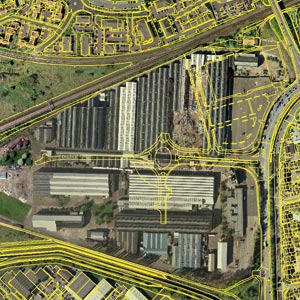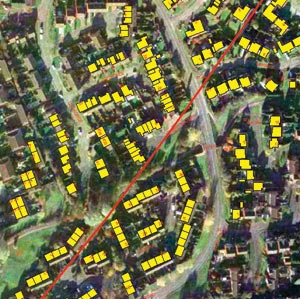Continuing his series of articles on digital mapping, James Cutler, emapSite takes a closer look at the use of imagery and aerial photography and their value to disciplines across the Architecture, Engineering, Construction sector.
Previous articles have focused on (re)introducing OS MasterMap to an AEC audience under pressure to achieve more with less more quickly and encumbered by the prospect of the demise of familiar large scale mapping and the need to adopt OS MasterMap. The number of organisations now using OS MasterMap (over 10,000) along with the productivity gains, performance benefits and ease-of-use now evident serve to illustrate that technicians and project managers alike will be able to realise these goals.
Beyond
Not only is OS MasterMap Topography Layer (to give the core product its full title) much more than a replacement for Land-Line/SuperPlan, but it is the first in a whole series of digital mapping and related products. This article serves to raise the profile of imagery and aerial photography in particular and its value to disciplines across the AEC sector.
The term imagery has historically been associated by many with satellites and relatively wide area coverage not particularly relevant to UK based CAD and GIS users. Aerial photography on the other hand has long been recognised as a valuable if sometimes costly tool in site reconnaissance and contextual analysis containing as it does a more accessible (in the widest sense) view of the area concerned and providing, either on its own or in combination with other mapping, the facility to highlight sub-surface features, generate 3D urban landscapes, identify land use and much more. Photogrammetry is the (series of) technique(s) used to extract both 2D and 3D geographic information from aerial photographs and associated capture parameters. The resulting 3D models are relevant to any number of applications including noise and pollution modeling, pipeline routing, telecommunications installation planning and earthworks measurement.
The evolution of technology in the imagery/remote sensing sphere and the emergence of a consistent national database of aerial photography means that CAD and GIS users now have a plethora of choices when it comes to augmenting their applications and communicating with project managers and other stakeholders.
Many consulting engineers and environmental consultants have over the last five years come to see aerial photography as a vital and cost-effective adjunct to their day-to-day activities. For example, photography played a role in planning site sampling surveys on the Isle of Sheppey while it was also used to provide a real-world context during public consultation on the Biggleswade bypass.
Behind
It is perhaps not commonly known that while OS MasterMap Imagery layer represents but one source for consistent aerial photography (others include getmapping, UK Perspectives, Cities Revealed and their resellers), Ordnance Survey has long operated its own air survey squadron. OS has used this resource on an ad hoc basis to capture traditional aerial photography to aid in the process of updating the large scale map database of which OS MasterMap Topography is the most visible outcome.
It is possible to acquire some of this data through the OS Options network in hardcopy non-ortho-corrected form (i.e. with all the errors caused by terrain, aircraft attitude, camera and atmosphere, collectively most noticeable in the form of distortion away from the centre of the photo). And herein lies both the challenge facing the suppliers and the understanding required by the user – not only are there diverse sources but imagery itself can take many forms.
The GIS, CAD and visualisation professional now has a wider and more competitively priced choice of imagery than ever before whatever their application
Traditional pairs of hardcopy airphotos are still used (with a stereoscope) for land cover mapping and other (normally resource planning) applications. Photogrammetry has evolved into a “softcopy” discipline in which digital stereo-pairs are processed using a variety of semi-automated workflows to derive planimetrically accurate 2D and 3D airphoto mosaics, terrain products, contour maps and much more. The initial data capture solution (film camera, digital sensor, small format camera), processing approach and type of product required determine the degree of precision used in the photogrammetric process, the tolerances accepted, the accuracies resulting and to some extent the fitness for purpose of the final products. They also contribute significantly to the price of the product in the market place! These are all factors that the user needs to consider and in which technically proficient resellers provide a balanced assessment and choice.
Above
Commercial aerial photography with a spatial resolution (or detail level) that enables individual trees, outhouses and even livestock to be discriminated from their surroundings is now common-place and costs have been decreasing owing to competition both within this market and from the new generation of satellite borne imagery and other airborne tools.
Chief amongst these has been the new generation of very high resolution satellite borne sensors (often referred to collectively as VHR). VHR sensors have a detail level close to aerial photography, a much greater simultaneous capture area and a higher frequency of site overpass than aerial photography. In addition the resulting images are easier to understand and more analogous to aerial photographs than previous generations of satellite image. Hence, it is easy to understand how Quickbird, IKONOS, IRS and SPOT have become serious options for project management, emergency services , urban planning and other disciplines when seeking up to the minute visually valuable information on which to overlay and contextualise other detailed information, be it address, route or district specific. As the VHR suppliers struggle with business models that make such information accessible on a near-real-time basis for small sites (i.e. without punitive satellite commissioning charges and minimum orders) there is no question that the huge volumes of archive data being stored represents a true challenge to aerial photography.
Aerial photography providers have responded with the take up of a new generation of capture technologies and the ability to promise of far greater detail (5-6.25cm) for urban areas, more frequent coverage and faster delivery. In addition there has been an increase in the use of online channels (for example, www.google.com) and the emergence of new tools for visualisation (for example, www.pictometry.com).
In the UK weather conditions have been the long-time enemy of all image capture ventures and this is not likely to change any time soon. However, the GIS, CAD and visualisation professional now has a wider and more competitively priced choice of imagery than ever before whatever their application.
This article was written by James Cutler, CEO at eMapSite







